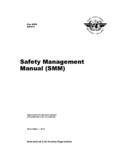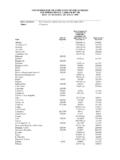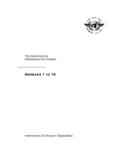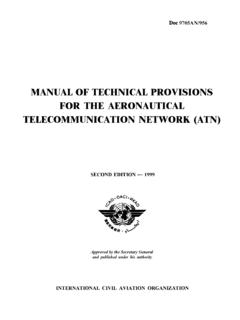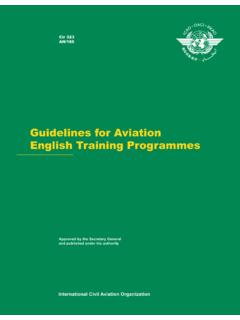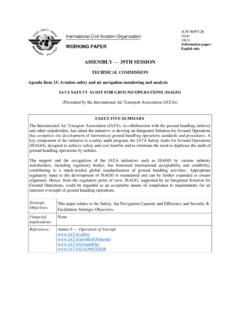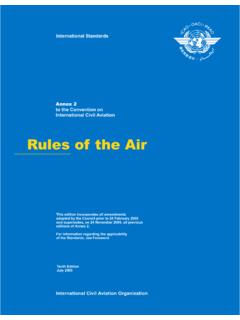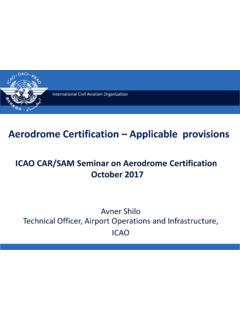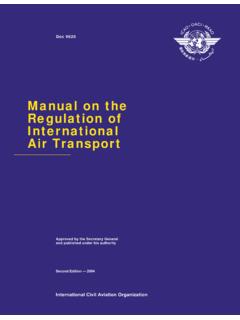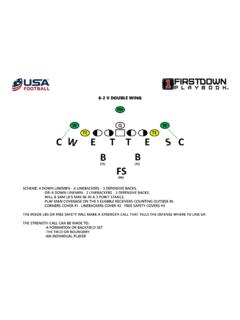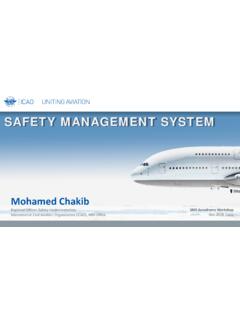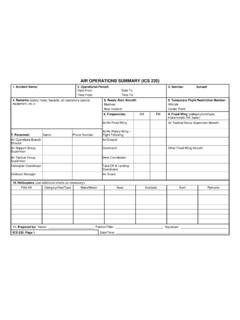Transcription of Manual Aerodrome Stds. - ICAO
1 Aerodrome STANDARDS. Aerodrome DESIGN AND OPERATIONS. This Manual is based on ICAO Annex 14, Third Edition July 1999. and is fully compliant with that document. AMENDMENTS. RECORD OF AMENDMENTS AND CORRIGENDA. AMENDMENTS CORRIGENDA. Date Date Entered Date Date Entered No. applicable entered by No. of issue entered by ii TABLE OF CONTENTS. Page Abbreviations and symbols; manuals . FOREWORD . CHAPTER 1. General . Definitions . Applicability . Reference code . CHAPTER 2. Aerodrome data . Aeronautical data . Aerodrome reference point . Aerodrome and runway elevations . Aerodrome reference temperature . Aerodrome dimensions and related information . Strength of pavements .. Pre-flight altimeter check location . Declared distances . Condition of the movement area and related facilities . Disabled aircraft removal .. Rescue and fire fighting . Visual approach slope indicator systems.
2 Coordination between aeronautical information services and Aerodrome authorities . CHAPTER 3. Physical characteristics . Runways . Runway shoulders . Runway strips .. Runway end safety areas . Clearways . Stopways . Radio altimeter operating area . Taxiways . Taxiway shoulders . Taxiway strips . Holding bays, runway-holding positions, intermediate holding positions and road-holding positions Aprons .. Isolated aircraft parking position .. De/anti-icing facilities . CHAPTER 4. Obstacle restriction and removal . Obstacle limitation surfaces . Obstacle limitation requirements . Objects outside the obstacle limitation surfaces . Other objects .. CHAPTER 5. Visual aids for navigation . Indicators and signalling devices . Wind direction indicators . iii Landing direction indicator . Signalling lamp . Signal panels and signal area . Markings . General . Runway designation marking.
3 Runway centre line marking . Threshold marking . Aiming point marking .. Touchdown zone marking . Runway side stripe marking . Taxiway centre line marking . Runway-holding position marking . Intermediate holding position marking . VOR Aerodrome check-point marking . Aircraft stand markings . Apron safety lines . Road-holding position marking . Mandatory instruction marking . Information marking . Lights . General . Emergency lighting . Aeronautical beacons . Approach lighting systems . Visual approach slope indicator systems .. Circling guidance lights . Runway lead-in lighting systems .. Runway threshold identification lights . Runway edge lights .. Runway threshold and wing bar lights . Runway end lights . Runway centre line lights . Runway touchdown zone lights .. Stopway lights . Taxiway centre line lights .. Taxiway edge lights .. Stop bars . Intermediate holding position lights.
4 De/anti-icing facility exit lights . Runway guard lights . Apron floodlighting . Visual docking guidance system . Aircraft stand manoeuvring guidancelights . Road-holding position light . Signs . General . Mandatory instruction signs . Information signs . VOR Aerodrome check-point sign . Aerodrome identification sign . Aircraft stand identification signs . Road-holding position sign .. iv Markers . General . Unpaved runway edge markers . Stopway edge markers . Edge markers for snow-covered runways . Taxiway edge markers . Taxiway centre line markers . Unpaved taxiway edge markers .. Boundary markers .. CHAPTER 6. Visual aids for denoting obstacles . Objects to be marked and/or lighted . Marking of objects . Lighting of objects . CHAPTER 7. Visual aids for denoting restricted use areas . Closed runways and taxiways, or parts thereof . Non-load-bearing surfaces.
5 Pre-threshold area .. Unserviceable areas . CHAPTER 8. Equipment and installations .. Secondary power supply .. Electrical systems . Monitoring . Fencing . Security lighting . Airport design .. Siting and construction of equipment and installations on operational areas . Aerodrome vehicle operations . Surface movement guidance and control systems .. CHAPTER 9. Emergency and other services . Aerodrome emergency planning . Rescue and fire fighting . Disabled aircraft removal .. Maintenance . Bird hazard reduction .. Apron management service . Ground servicing of aircraft . APPENDIX 1. Colours for aeronautical ground lights, markings, signs and panel .. 1. General . 2. Colours for aeronautical ground lights . 3. Colours for markings, signs and panels . APPENDIX 2. Aeronautical ground light characteristics . APPENDIX 3. Mandatory instruction markings and information markings.
6 APPENDIX 4. Requirements concerning design of taxiing guidance signs . APPENDIX 5. Aeronautical data quality requirements . APPENDIX 6. Location of lights on obstacles .. v ATTACHMENT A. Guidance material supplementary to Manual of Aerodrome Standards.. 1. Number, siting and orientation of runways . 2. Clearways and stopways . 3. Calculation of declared distances . 4. Slopes on a runway . 5. Runway surface evenness . 6. Determining and expressing the frictioncharacteristics of snow- and ice-covered paved surfaces . 7. Determination of friction characteristics of wet paved runways . 8. Strips . 9. Runway end safety areas . 10. Location of threshold . 11. Approach lighting systems .. 12. Priority of installation of visual approach slope indicator systems . 13. Lighting of unserviceable areas . 14. Intensity control of approach and runway lights .. 15. Signal area.
7 16. Rescue and fire fighting services .. 17. Operators of vehicles .. 18. The ACN-PCN method of reporting pavement strength .. ATTACHMENT B. Obstacle limitation surfaces . LIMITED INDEX OF SIGNIFICANT SUBJECTS INCLUDED IN Manual OF Aerodrome STANDARDS. ABBREVIATIONS AND SYMBOLS. (used in Manual of Aerodrome Standards). Abbreviations ACN Aircraft classification number aprx Approximately ASDA Accelerate-stop distance available ATS Air traffic services cd Candela C Degree Celsius CBR California bearing ratio CIE Commission Internationale de l= clairage cm Centimetre DME Distance measuring equipment ft Foot ILS Instrument landing system IMC Instrument meteorological conditions K Degree Kelvin kg Kilogram km Kilometre km/h Kilometre per hour kt Knot L Litre LDA Landing distance available m Metre max Maximum mm Millimetre vi mnm Minimum MN Meganewton MPa Megapascal NM Nautical mile NU Not usable OCA/H Obstacle clearance altitude/height OFZ Obstacle free zone PCN Pavement classification number RESA Runway end safety area RVR Runway visual range TODA Take-off distance available TORA Take-off run available VMC Visual meteorological conditions VOR Very high frequency omnidirectional
8 Radio range Symbols Degree = Equals _ Minute of arc Friction coefficient > Greater than < Less than % Percentage _ Plus or minus MANUALS. (related to the specifications of this Manual of Aerodrome Standards)). ICAO Aerodrome Design Manual (Doc 9157). Part 1 C Runways Part 2 C Taxiways, Aprons and Holding Bays Part 3 C Pavements Part 4 C Visual Aids Part 5 C Electrical Systems Part 6 C Frangibility (in preparation). Airport Planning Manual (Doc 9184). Part 1 C Master Planning Part 2 C Land Use and Environmental Control Part 3 C Guidelines for Consultant/Construction Services ICAO Airport Services Manual (Doc 9137). Part 1 C Rescue and Fire Fighting Part 2 C Pavement Surface Conditions Part 3 C Bird Control and Reduction Part 4 C Fog Dispersal (withdrawn). Part 5 C Removal of Disabled Aircraft Part 6 C Control of Obstacles Part 7 C Airport Emergency Planning Part 8 C Airport Operational Services Part 9 C Airport Maintenance Practices vii Heliport Manual (Doc 9261).
9 Stolport Manual (Doc 9150). Manual on the ICAO Bird Strike Information System (IBIS) (Doc 9332). Manual of Surface Movement Guidance and Control Systems (SMGCS) (Doc 9476). viii FOREWORD. Historical background Standards and Recommended Practices for Aerodromes were first adopted by the Council on 29 May 1951 pursuant to the provisions of Article 37 of the Convention on International Civil Aviation (Chicago 1944) and designated as ICAO Annex 14. to the Convention. The Standards and Recommended Practices were based on recommendations of the Aerodromes, Air Routes and Ground Aids Division at its third session in September 1947 and at its fourth session in November 1949. Status of Manual Components a) Standard : Any specification for physical characteristics, configuration, material, performance, personnel or procedure, the uniform application of which is recognized as necessary for the safety or regularity of international air navigation.
10 B) Appendices comprising material grouped separately for convenience but forming part of this Standards. c) Definitions of terms used in the Standard which are not self- explanatory in that they do not have accepted dictionary meanings. A definition does not have independent status but is an essential part of each Standard in which the term is used, since a change in the meaning of the term would affect the specification. d) Tables and Figures which add to or illustrate a Standard and which are referred to therein, form part of the associated Standard and have the same status. e) Notes included in the text, where appropriate, to give factual information or reference bearing on the Standards in question, but not constituting part of the Standards. f) Attachments comprising material supplementary to the Standards or included as a guide to their application. Editorial practices The units of measurement used in this document are in accordance with the International System of Units (SI) as specified in ICAO Annex 5 to the Convention on International Civil Aviation.

